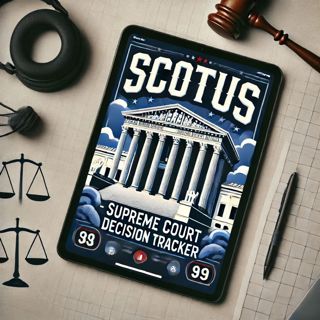
Unprecedented Supreme Court Shadow Docket Usage Raises Transparency Concerns
Major news regarding the U.S. Supreme Court in the last three days centers on the ongoing debate over the Court’s use of its so-called shadow docket, which has reached unprecedented levels in the current term. The shadow docket, traditionally reserved for routine, procedural matters, is now being used far more frequently and for more consequential rulings—often without detailed explanations or disclosure of how individual justices voted. According to SCOTUSblog, the number of emergency matters on the shadow docket has soared from 44 in the previous term to 113 in the current one as of late June, reflecting a dramatic increase under the new presidential administration. Legal experts and commentators, including those quoted in The IE Voice, warn that this trend risks further eroding public confidence in the Court’s transparency and impartiality, especially as the shadow docket is increasingly used for decisions that have significant policy and civil rights implications, such as immigration enforcement and other regulatory actions.Attention has also been drawn to how these emergency rulings, often delivered without full briefing or oral arguments, can leave lower courts and federal agencies uncertain about the reasoning behind the Court’s decisions. Critics argue that this practice undermines the usual process of judicial review and accountability, making it harder for the public to understand or challenge the Court’s actions. The broader concern is that expanded use of the shadow docket contributes to the perception that the judiciary is becoming less transparent and more politically influenced at a time when the balance of power among the three branches of government is already under scrutiny.Looking ahead, the Supreme Court will soon consider a request from the National Basketball Association regarding the Video Privacy Protection Act, with briefing scheduled to conclude and arguments potentially to follow in the coming weeks. This case could have important implications for digital privacy and the scope of protections under federal law, though no decision has been announced as of the last three days.Thank you for tuning in for this quiet please production. For more, check out quiet please dot ai.For more http://www.quietplease.aiGet the best deals https://amzn.to/3ODvOtaThis content was created in partnership and with the help of Artificial Intelligence AI
17 Sep 2min

Supreme Court Sparks Controversy with Landmark Immigration Ruling
During the past few days, the US Supreme Court has captured headlines with a deeply contentious emergency order in the Noem v. Vasquez Perdomo immigration case. On September 8, the Court granted the federal government’s request to pause a lower court ruling that had blocked aggressive immigration raids in Los Angeles. These raids involved armed federal agents detaining people, often based on perceived race, language, and type of employment, raising significant concerns over constitutional rights and equal treatment. Justice Kavanaugh’s concurrence argued that factors like language and job type could be relevant for agents to develop reasonable suspicion, particularly in areas with high numbers of undocumented immigrants. By contrast, Justice Sotomayor, joined by Justices Kagan and Jackson, issued a forceful dissent, warning that the Court’s decision effectively sanctioned discriminatory police tactics and created risks for millions of innocent Latino workers and Spanish speakers.This ruling has immediate implications for immigrant communities and citizens alike, as federal agents are now able to continue raids using disputed criteria while the legal battle continues. The Ninth Circuit Court of Appeals is set to hear arguments on this issue soon, meaning the Court’s emergency stay may precede a more substantial review. Legal experts and advocacy groups have also pointed to the broader trend of the Supreme Court relying on emergency rulings, labeled the “shadow docket,” which often circumvent traditional argument and deliberation.In addition, there’s renewed scrutiny on the Supreme Court’s growing role in expanding executive powers, with critics arguing recent interventions frequently bolster federal government authority and narrow paths for individuals to hold agents accountable for wrongdoing. Notably, Justice Kavanaugh has been a focus of public protests, especially at a Texas event where demonstrators rebuked his past votes and the Court’s controversial ruling granting broad presidential immunity last year. Survey data from Gallup recently revealed that the Supreme Court’s approval rating slid to a new low of 39 percent, indicating rising public distrust and sharp partisan divides over its decisions.Looking ahead, listeners can expect further decisions on major issues including tariffs, immigration, federal spending, and executive authority—especially as high-profile cases around former President Donald Trump’s actions are docketed for review. For now, the Court’s latest rulings underscore its decisive impact on national policy, civil rights, and the evolving balance of power in American government.Thanks for tuning in, and don’t forget to subscribe. This has been a quiet please production, for more check out quiet please dot ai.For more http://www.quietplease.aiGet the best deals https://amzn.to/3ODvOtaThis content was created in partnership and with the help of Artificial Intelligence AI
15 Sep 2min

Supreme Court Reshapes Immigration Enforcement and Presidential Powers
The US Supreme Court has made major headlines in the past several days, starting with a controversial decision that drew strong reactions from immigrant rights groups. On Monday, the Court's conservative majority used a shadow docket ruling to allow federal immigration officials to reinstate practices that many civil rights advocates have described as enabling discriminatory and even racist tactics. According to Immigrants Rising and reporting from TIME, this means agents can now stop suspects based on race, language, or occupation while broader legal challenges continue, particularly impacting communities in Los Angeles and igniting protests from organizations concerned about racial profiling and abuse.While the Supreme Court's decision on this matter is not final, it does clear the way for such enforcement practices to resume immediately, at least until further hearings later this month in the lower courts. Advocates are preparing to contest the decision vigorously, and the outcome could shape immigration enforcement practices across the country in the near future.On another front, the Court has moved quickly to address the legal limits of presidential emergency powers, agreeing this week to hear a high-profile challenge to former President Donald Trump's authority to impose sweeping tariffs under the International Emergency Economic Powers Act, known as IEEPA. After an August ruling by the US Court of Appeals for the Federal Circuit struck down Trump's emergency tariffs—saying the Act did not grant the president such sweeping authority—the government immediately appealed for Supreme Court review. The high court has responded with rare urgency, expediting the case and demanding all briefs be submitted by September 19, in preparation for in-person arguments set for early November. Small businesses and states challenging the tariffs argue that the president overstepped his constitutional and statutory limits, while the White House insists the tariffs are both lawful and necessary for national security and economic interests.These fast-moving developments highlight the Supreme Court's major influence over US immigration policy and the scope of presidential power. As high stakes cases land on the Court's docket, major policy and legal battles are set to play out in the coming weeks, watched closely by policymakers, interest groups, and the public.Thanks for tuning in, and don't forget to subscribe. This has been a Quiet Please production, for more check out quiet please dot ai.For more http://www.quietplease.aiGet the best deals https://amzn.to/3ODvOtaThis content was created in partnership and with the help of Artificial Intelligence AI
10 Sep 2min

Headline: Supreme Court Faces Intensifying Scrutiny Over 'Shadow Docket' and Executive Power Battles
A major focus right now at the Supreme Court is the intensifying scrutiny over its use of the emergency, or “shadow,” docket. According to NBC News and commentary on The Daily Beans podcast, ten federal judges have publicly criticized the Court’s increasing reliance on this emergency process, raising concerns about the lack of transparency and accountability in deciding high-stakes legal questions without full briefings or oral arguments. This rare move, involving sitting judges giving interviews, signals mounting tension and divided opinion throughout the federal judiciary.Meanwhile, attention is turning to an expedited Supreme Court case involving the Trump administration’s authority to impose broad national security tariffs under the International Emergency Economic Powers Act. The Federal Circuit found the tariffs unlawful, arguing that Congress had not clearly given the President such sweeping tariff power, and this decision is already causing international uncertainty and economic dislocation, as Reuters has reported. The administration and the opposing parties have agreed on a fast-tracked hearing schedule that could see briefs and oral argument take place before the end of the year, making this one of the most consequential cases currently before the Justices, with huge implications for executive power and U.S. economic policy.In addition, federal courts outside the Supreme Court have recently ruled against several of the administration’s controversial actions, including planned mass deportations, deploying the National Guard in American cities, and funding cuts to states and universities. These defeats are expected to make their way up to the Supreme Court, underscoring how the Court will soon be forced to address the legal boundaries of recent executive branch initiatives. SCOTUSblog indicates that the Trump administration is seeking alternative legal footing to maintain its policy priorities, confident that the conservative majority may ultimately side with executive authority.There’s also a spotlight on internal tensions within the judiciary, following recent public exchanges between Justice Neil Gorsuch and lower court judges about how binding the Court’s emergency orders truly are. Former Justice Stephen Breyer has emerged to defend a trial judge recently criticized by Gorsuch, describing him as honest and respectful of the Supreme Court, which both highlights and complicates the ongoing debate about judicial hierarchy and respect within the federal courts.To summarize, the Supreme Court faces pressure from both within the judiciary and the public to clarify its approach to the emergency docket and to rule on defining questions about presidential authority in trade and immigration. All of these developments suggest a period of unusual visibility, political stakes, and institutional debate for the highest court in the United States.Thanks for tuning in and don’t forget to subscribe. This has been a quiet please production, for more check out quiet please dot ai.For more http://www.quietplease.aiGet the best deals https://amzn.to/3ODvOtaThis content was created in partnership and with the help of Artificial Intelligence AI
8 Sep 3min

Supreme Court Turmoil: Immigration, Trade, and Emergency Rulings Spark Controversy
Listeners, the US Supreme Court has been at the center of several high-profile developments in recent days, with headline news focusing sharply on immigration, trade, and its own handling of emergency cases. Federal courts are clashing over Trump-era immigration policies, particularly the fate of protections for Venezuelans and Haitians under Temporary Protected Status, or TPS. This turmoil stems from the Trump administration's aggressive efforts to revoke these humanitarian protections for over a million people. A federal judge just blocked the administration’s move to end TPS for Haitians and Venezuelans, arguing the actions were unlawful and caused widespread harm through deportations and family separations. However, the Supreme Court earlier allowed the administration’s policy to take effect temporarily as the case continues, leading to chaos and uncertainty for thousands. Legal analysts from the ACLU and UCLA’s Center for Immigration Law note that many people have already suffered, with loss of work authorization, detainment, and removals before yesterday’s ruling restored protections, at least provisionally.On the trade front, a significant legal battle is playing out over President Trump’s sweeping tariffs, imposed under the International Emergency Economic Powers Act. A coalition of small businesses has asked the Supreme Court to intervene after a federal appeals court struck down these tariffs, arguing Trump exceeded his authority under current law. The tariffs, affecting numerous countries for alleged roles in the fentanyl crisis and violating trade reciprocity, have caused serious supply chain disruptions and economic strain, prompting urgent calls for Supreme Court resolution. Trump’s legal team is pushing for expedited review, claiming that these tariffs are essential for American economic security and global negotiating power. If the court upholds the lower court ruling, billions in tariffs could potentially be refunded, creating another wave of legal and financial complications.Meanwhile, some legal scholars and district court judges are openly frustrated by what they call the Supreme Court’s vague and often unexplained emergency rulings, especially on the so-called shadow docket. According to analysis from The New Republic, this approach has left district courts and litigants without clear guidance, undermining confidence across the judiciary. The tension is heightened by perceptions that the Court’s standards fluctuate depending on which administration is in power, fueling a broader debate about the integrity and impartiality of emergency Supreme Court decisions.As these matters unfold, the Supreme Court is under mounting pressure to clarify its position on executive authority, immigration relief, and its own process—a dynamic sure to shape the national legal landscape in the coming weeks. Thank you for tuning in. Be sure to subscribe for more updates. This has been a Quiet Please production, for more check out quiet please dot ai.For more http://www.quietplease.aiGet the best deals https://amzn.to/3ODvOtaThis content was created in partnership and with the help of Artificial Intelligence AI
7 Sep 3min

Supreme Court Battles: Tariffs, Immigration, and the Limits of Presidential Power
Listeners, over the past few days, the US Supreme Court has been front and center in major legal and political battles, particularly due to ongoing cases affecting presidential powers, immigration, and international trade.The Trump administration’s economic agenda is at stake as President Trump has just asked the Supreme Court to step in quickly and review a recent federal appeals court decision that struck down many of his signature tariffs. The ruling determined that Trump overstepped his authority under the International Emergency Economic Powers Act when he imposed sweeping tariffs on America’s trading partners, both as a measure to address trade deficits and in response to the influx of fentanyl. According to News9, the administration has urged the court to rule by next week, emphasizing the urgency due to market instability and ongoing negotiations with foreign governments. The White House asserts that if the court allows the appeals decision to stand, it could unravel existing trade agreements, force America to repay billions in tariffs, and deal a significant blow to the president's ability to respond to foreign threats and conduct diplomacy.Another major headline centers on the aftermath of the Court’s spring decision involving the wrongful deportation of Salvadoran national Ábrego García. SCOTUSblog highlights how the Supreme Court unanimously ordered federal officials to bring him back to the country after he was mistakenly deported, clarifying federal obligations in cases of administrative error. Since his return and subsequent legal battles, the broader issue of executive deportation powers remains fiercely contested, and the case illustrates the real-world impact of Supreme Court intervention.Immigration, executive authority, and judicial checks are recurring themes, especially as the Court continues to confront the limits of presidential power. Earlier in the term, the Court issued decisions limiting some emergency powers but also, as documented by the US Studies Centre, notably sided with the president in expedited emergency applications—often without full briefing or explanation—allowing the administration to move ahead on critical issues like deportations and removals of independent federal agency heads.Looking forward, listeners should expect more rapid-fire decisions on these high-profile disputes, as the Trump administration has pushed for expedited Supreme Court timelines. Both advocates and critics agree that the Court’s balance of power, use of its emergency “shadow docket,” and willingness to influence major policy areas will remain contentious political issues as the presidential term progresses.Thank you for tuning in, and make sure to subscribe for continuous Supreme Court coverage and analysis. This has been a Quiet Please production, for more check out quietplease dot ai.For more http://www.quietplease.aiGet the best deals https://amzn.to/3ODvOtaThis content was created in partnership and with the help of Artificial Intelligence AI
5 Sep 2min

"Supreme Court Grapples with Tariffs, Voting Rights, and More: A Comprehensive Update"
Supreme Court watchers have seen a busy few days. The Trump administration is seeking an expedited Supreme Court ruling on the legality of new tariffs it imposed under the International Emergency Economic Powers Act, after a major appellate court ruling went against the administration’s orders. These tariffs—especially the ones applied to Canadian, Mexican, and Chinese goods—could remain in effect for at least another month while the administration gears up for its Supreme Court appeal, and if the justices take the case, it could lead to a significant decision on presidential powers to regulate international trade and emergencies. Importers and trade partners are anxious about potential retroactive refunds, depending on how the Supreme Court ultimately rules.Meanwhile, voting rights are squarely in the spotlight following a petition that asks the Supreme Court to decide whether private citizens can still sue under Section 2 of the Voting Rights Act. The urgency is high after an appeals court ruled only the federal government can enforce this law, directly contradicting decades of practice where private individuals were the main enforcers against racially discriminatory voting laws. Native American voters and advocacy groups want the Supreme Court to reaffirm the rights of private plaintiffs, and the justices have temporarily paused the ruling that limits private enforcement while they consider taking the case.In grant dispute news, the Supreme Court recently made an impact by signaling that challenges to federal grant terminations—such as those brought against the National Institutes of Health—are fundamentally contract disputes. This means such cases should be heard in the Court of Federal Claims, not federal district courts. The decision could have broad ramifications for disputes over billions of dollars in federal funding, not just in biomedical research but also in areas like energy and education.Immigration is also front and center, with the Trump administration pressing the Supreme Court to review several policies, including legal questions over asylum seekers at the southern border and the president’s recent order ending birthright citizenship. Court filings highlight the administration’s desire to settle these contentious issues during the coming term.Data privacy and administrative access are another flashpoint. The Supreme Court recently lifted lower court orders that blocked government access to sensitive Social Security Administration data, siding with the administration and allowing the contested access even as dissenters warned about serious privacy risks for millions of Americans. Separately, the Court lifted orders safeguarding the lawful status of about half a million noncitizen residents, further solidifying the administration’s firm stance on immigration enforcement before a full legal review.Notably, Justice Amy Coney Barrett made headlines with new comments defending the decision overturning Roe v. Wade and offering insights into current Supreme Court dynamics, drawing additional attention to the Court’s evolving conservative approach.Finally, there’s an unusual property case: an Alaska man whose plane was seized over a six-pack of beer has asked the Supreme Court to review the forfeiture, tapping into ongoing debates about civil asset seizures and due process.Thanks for tuning in, and don’t forget to subscribe. This has been a Quiet Please production, for more check out quiet please dot ai.For more http://www.quietplease.aiGet the best deals https://amzn.to/3ODvOtaThis content was created in partnership and with the help of Artificial Intelligence AI
3 Sep 3min

Supreme Court Rulings Set to Reshape Presidential Powers and Trade Policy
Supreme Court news is focused on several high-impact cases and rulings that could reshape the powers of the presidency and U.S. trade policy. According to The Wall Street Journal and The Washington Post, one of the biggest developments concerns ongoing legal battles over former President Trump's use of emergency powers to impose tariffs on multiple countries, including China, Mexico, and Canada. A federal appeals court recently ruled these tariffs unlawful, stating that the International Emergency Economic Powers Act, or IEEPA, does not grant the president the authority to set tariffs without explicit congressional approval. However, the ruling will not take effect until mid-October to allow time for the administration to appeal to the Supreme Court. Legal observers note that this case will test the "critical problem principle" established in 2022, which limits a president's ability to take sweeping actions without a clear delegation of authority from Congress.At the same time, The Washington Post highlights several other cases currently before the Supreme Court that could redefine the boundaries between executive, legislative, and independent agency power. These include President Trump's attempt to remove Lisa Cook from the Federal Reserve Board of Governors, which has sparked a lawsuit likely to make its way to the high court, and challenges over the president's suspension of foreign aid and other major policy shifts. Experts suggest the totality of these cases could represent the most significant test in decades of presidential authority versus congressional power.In another important development, Fox News reports that a federal judge recently blocked a Trump administration policy allowing expedited deportations of undocumented immigrants who have been in the country for less than two years, finding it violated due process rights. This, too, is expected to be appealed.Additionally, the Supreme Court made headlines by allowing the National Institutes of Health to terminate grants, setting new precedent for agency litigation. This follows up on a previous Department of Education case, expanding federal authority in discretionary grant management.All these issues are set against the backdrop of a Supreme Court with a solid conservative majority, which analysts say could influence the outcomes, especially since three current justices were nominated by Trump himself. The Supreme Court is expected to hear arguments on the administration’s appeal over the tariffs this winter or early spring, with a decision likely to come weeks or months after oral arguments.Thanks for tuning in and make sure to subscribe. This has been a quiet please production, for more check out quiet please dot ai.For more http://www.quietplease.aiGet the best deals https://amzn.to/3ODvOtaThis content was created in partnership and with the help of Artificial Intelligence AI
1 Sep 2min





















